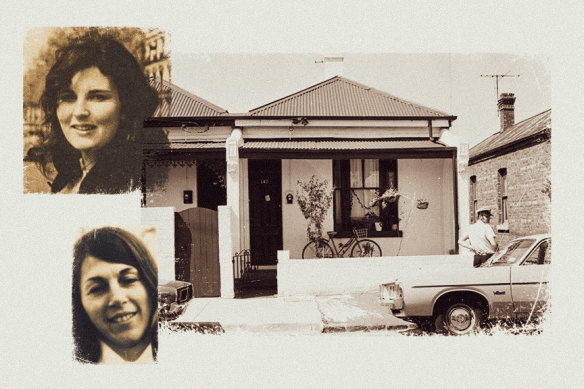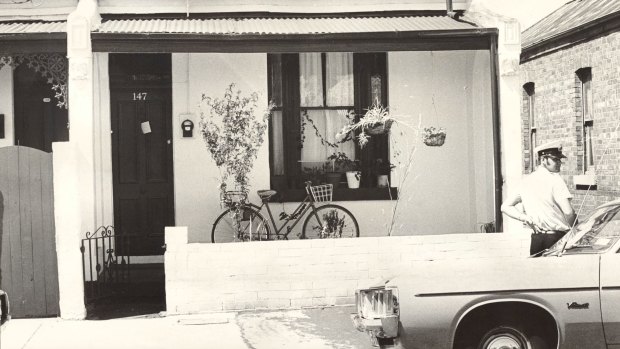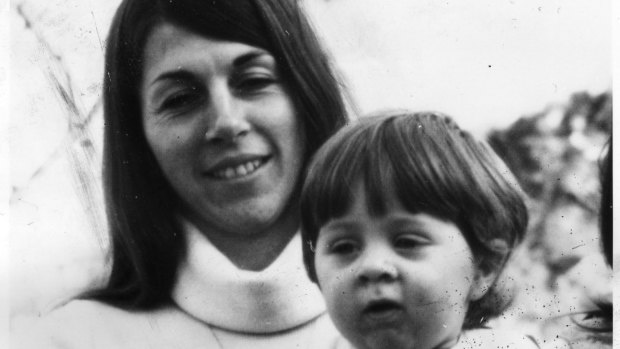- Analysis
- National
- Victoria
- Naked City
This was published 10 months ago
How police tracked the Easey Street suspect
The Easey Street suspect was identified through a DNA test when police undertook to check the 131 people listed in the original police file in the murders of housemates Suzanne Armstrong and Susan Bartlett, who were stabbed to death in their rented Collingwood home.
In 2017, when the suspect learnt he was being investigated over the double murder, he fled to Athens and as he is an Australian-Greek citizen, he was protected from extradition under Greek law.

Susan Bartlett (top) and Suzanne Armstrong were killed in their Easey Street, Collingwood rental in 1977.Credit: Stephen Kiprillis
Soon after the night of the murders – January 10, 1977 – a teenage boy was stopped and searched by a local police patrol and found to be carrying a large knife. But it appears he was not listed as a suspect at the time. The bodies of the woman were not found for days.
It was understood the boy was never interviewed as police concentrated on key suspects – men who knew the victims and may have previously been to the Easey Street house.
In January 2017, police announced they would test 90 living and 41 dead people connected to the file.
In the process, the boy found with the knife – by then a 57-year-old man – was contacted and agreed to undergo a DNA test, but failed to attend a meeting to provide a sample.

The Easey Street, Collingwood home in 1977, where the women were murdered.
The man, of Greek descent, flew to Athens about seven years ago and refused to return despite saying he was going for a short holiday. A DNA sample taken from a close relative has matched to a semen sample found under the body of Armstrong, 27.
Under Greek law, an extradition can be granted only if the offence is punishable under local law. In Greece, there is a strict statute of limitations: a prosecution must begin within 20 years of the offence, so the offence, which was more than 15 years ago, was not punishable under local law.
In fact, the Easey Street murders were committed more than 40 years before the suspect fled, and under sections 111 to 116 of the Greek criminal code are time-barred.
Victoria Police used international lawyers to try to find a way to have the man return to face charges. Detectives also meticulously checked the suspect’s past to see if they could find any recent offences that would justify an extradition. It is understood the case was discussed through diplomatic channels.

Suzanne Armstrong with her son, Gregory. He was 16 months old when his mother was murdered.
Frustrated police decided to play a waiting game and move if the suspect visited a country with appropriate extradition laws. For six years this masthead has agreed to keep the breakthrough secret to avoid alerting the suspect.
Three days after the 1977 attack neighbours found the bodies.
Armstrong was on the floor in her bedroom. She’d been stabbed 27 times, with three wounds piercing her heart. She was also raped. Arts teacher Bartlett was found near the front door. She had been stabbed 55 times. Defensive wounds on her hands and arms indicated she had tried to defend herself before she was overwhelmed.
Police believe Bartlett, 28, may have tried to help her friend before she was also attacked. Lack of signs of forced entry led police to think one or both of the women may have known the killer.
The two Benalla schoolfriends had been renting the small cottage for about 10 weeks before the attack. They routinely left the backdoor and side gate open.
Armstrong had returned from Greece just months earlier. She had a baby son to a fisherman in the Greek Islands. The baby, Gregory, was found severely dehydrated when the bodies were discovered on January 13, 1977.
The then head of the homicide squad, Detective Inspector Noel Jubb, described it as “one of the most barbaric and sadistic sex murders in Victorian history”.
Initial investigators found blood through the house and in the bath, showing the killer stayed in the house for some time to wash. He made no effort to clean the crime scene. Both women were in sleepwear, the lights were on and the blinds drawn, indicating the attack happened on the evening of January 10.
Police had a shortlist of eight suspects from the original investigation, including a local crime reporter and a national sports figure. In 1998, detectives DNA tested all the key suspects without a match. The key semen sample was found the previous year in a storeroom with other Easey Street exhibits.
In 2017, the homicide squad announced a $1 million reward and plans to test the DNA of all persons of interest: 90 of them living and 41 who had since died.
The then head of the homicide squad, Detective Inspector Mick Hughes, said: “We have good DNA evidence and we obviously believe that is the key to the investigation. We’ve narrowed the field considerably. We haven’t got a match. If we did, I’d be knocking on someone’s door and making an arrest.
“We have been working through a lot of persons of interest. They come from a variety of sources. We’ve narrowed the field considerably.”
For more than 30 years there was a shortlist of eight men suspected of the murders.
While the case remains unsolved, all eight, including a Melbourne journalist, were finally cleared through DNA testing. Interestingly, one who wasn’t cleared, was a champion sportsman who is no longer with us.
Among Bartlett’s 55 stab wounds were slashes to her arms and hands from where she’d bravely tried to fight back. She was found lying face down near the front door.
There were smears along the hallway as if she’d made a lunge for it with bloodied hands. As she’d desperately tried to escape, she was knifed in the back and legs over and over. The killer hadn’t rushed away after the attack either.
The bathroom was a mess of bloodstains as though the killer tried to clean himself or wash away evidence. Then he’d walked out the back door and into the night.
Armstrong’s 16-month-old son, Gregory, was unharmed and was found in his cot three days later.
DNA evidence and advancements in testing resulted in police relaunching the investigation, including the $1 million reward.
Start the day with a summary of the day’s most important and interesting stories, analysis and insights. Sign up for our Morning Edition newsletter.